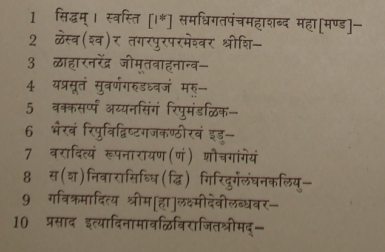|
The Indian Analyst
|
North Indian Inscriptions |
INSCRIPTIONS OF THE SILAHARAS OF KOLHAPUR
per honnu, granted by the assemblies of traders’ guilds and the goldsmith Nāgōj, to the basadi (and) the temple built by the assemblies; this davaṇ-āya income at the rate of (one) vīsa per honnu, should be equally distributed to the basadi and the temple by Rēvagāvuṇḍa, led by the assemblies. .. (Lines 20-24) Again, for (each) marriage, (celebrated) with the beating of drums in the street, and the marriage (celebrated) in the Chinna-ka(Kē)rī, (a tax of ) (one) hāga (in money) for (each) cloth of (i.e. sold by ?) the traders’ guilds, and for (each) cloth . . . . , (a tax) at the rate of (one) vīsa per honnu should be remitted. This revenue should be properly shared (by) the basadi and the temple. .. (This is followed by the usual imprecatory verse.)
No. 56 : PLATE CX .. THE stone bearing this inscription was noticed near the house of Gurugal at Jugal, a village in the Beḷgaon District of the Karnāṭak State. It was very briefly noticed in the Annual Report on Indian Epigraphy for 1953-54. No. 179, p. 35. It is edited here from an estampage supplied by the Chief Epigraphist. ..The present record is a fragment of the original. It measures 36 cm. in breadth. As its lower portion is broken away and lost, its height cannot be determined.
.. The characters are of the Kannaḍa alphabet regular for the period to which the record refers itself. The language is Kannaḍa, and the whole record is in prose. The only orthographical peculiarities noticed are the use of the dental s for the palatal ś, and of dhdhi for ddhi, both in line 8. .. The inscription refers itself to the reign of Vijayāditya, the Śilāhāra king ruling from his camp at Vaḷavāḍa. In lines 1 to 13 he is described as having borne several birudas, which are already known from other Śilāhāra records of the period. As the lower portion of the present record has been lost, the date and the object of it cannot be determined. The present inscription does not, therefore, make any addition to our knowledge of the history of the Śilāhāras of Kolhāpur, But it shows that the Beḷgaon District continued in their dominion in the reign of Vijayāditya. TEXT
|
|||||||||||||||||||||||||||||||||||||||||||||||||||||||||||||||||||||||||||||||||||||||||||||||||||||||||||||||||||||
| > |
|
>
|








